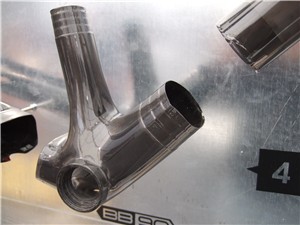
Improving on the legendary Madone 6.9 cannot have been an easy assignation for Trek’s top engineers, but they gave it their best shot and, going by both the blurb and the visual evidence, can reasonably claim to have succeeded.
Blurb first; Trek claims, not surprisingly, to have built a bike that ‘stands alone in every performance category’. Built along much the same lines as its predecessor, the Madone 6 Series is ‘the most technically advanced, exquisitely performing, and meticulously refined bicycle available -ever.’ Fair enough.
According to the figures, the frame, fork and seatmast come in 150g lighter than the previous model. While the fork is said to be 17% stiffer in the lateral plane, it and the seat mast yield 43% greater ‘compliance’ in the search for greater ride comfort.
Since the previous incarnation of the Madone, which was not exactly heavy, incorporated all sorts of carbon fibre trickery, how did the Wisconsin firm achieve all this? For starters, they got rid of all the unwanted resin that sits on the inside of most carbon tubes once the moulding process is finished. This process, named Resin Right, leaves the inside of the tubes smooth and saves precious grammes.
The seatmast now has a round cross section in place of the somewhat teardrop section of the old design, reducing the fore and aft cross section for added flex while lessening the amount of material needed.
The new Madone’s 6 Series Bontrager XXX Lite fork has what Trek calls an ‘asymmetric’ steerer tube; in fact, it is ovalised with the long axis oriented sideways to stiffen steering response, the short axis lowering frontal stiffness and allowing the fork better to soak up bumps. Reshaping the steerer also saves 30g. Note that the crown cladding of the old fork has been dispensed with in favour of an integral shaped design.
The best bit, however, is surely the new moulding technique developed for the tube joints. Like the old Madone, the tubes are moulded separately in sections and then bonded together, the technique allowing close control of wall thicknesses and tolerances. Where the 6.9 and its siblings used a straightforward sleeve, with one tube sliding over the undersized end of the other, the Series 6 employs Stepjoints, which, as their name implies, comprise a series of steps.
Stepped rings, in fact, each a reduction in external dimension and, on the inside of the mating tube, a matching increase. According to Trek, this ensures perfect mated surfaces for bonding with no overlapping, and therefore redundant, carbon fibre layers.
Impressive stuff, for sure, as is the internal cable routing and the DuoTrap sensor mount inside the left-hand chainstay, which allows a speed and cadence sensor to be integrated seamlessly into the frame.







